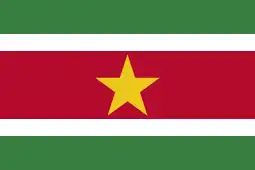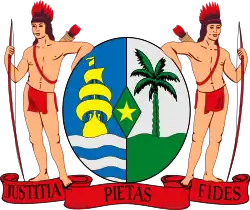 | |
| Total population | |
|---|---|
| c. 1,000,000 | |
| Regions with significant populations | |
| 612,985[1][2] | |
| 349,978[3][4] | |
| 32,412[5] | |
| 20,000[6] | |
| 14,555[5] | |
| 4,662[7] | |
| 3,000[8] | |
| 1,005[5] | |
| 1,000[5] | |
| 3,000[9] | |
| 28,000[9] | |
| 5,000[9] | |
| 7[10] | |
| Languages | |
| Dutch, Sranan Tongo[lower-alpha 1], Sarnami Hindustani, English, Ndyuka, Saramaccan, Matawai, Aluku, Paramaccan, Kwinti, Javanese, Chinese, Akurio, Arawak-Lokono, Carib-Kari'nja, Sikiana-Kashuyana, Tiro-Tiriyó, Waiwai, Warao, Wayana | |
| Religion | |
| Christianity, Hinduism, Islam, Winti, Kejawèn, Indigenous Amerindian religion, Irreligious | |
Surinamese people are people who identify with the country of Suriname. This connection may be residential, legal, historical or cultural. For most Surinamese, several (or all) of these connections exist and are collectively the source of their being Surinamese.
Suriname is a multiethnic and multilingual society, home to people of various ethnic, racial, religious, and national origins, with the majority of the population made up of Old World immigrants and their descendants. As a result, the Surinamese do not equate their nationality with ethnicity, but with citizenship and allegiance to Suriname. Aside from the indigenous population, nearly all Surinamese or their ancestors arrived since the Age of Discovery and establishment of the colony of Surinam, primarily from Africa, Europe and Asia.
Ethnic groups
The population of Suriname is made up of various distinguishable ethnic groups:
- Indigenous Surinamese, the original inhabitants of Suriname, form 3.7% of the population. The main groups are the Akurio, Arawak, Kalina (Caribs), Tiriyó and Wayana.
- Afro-Surinamese form about 37% of the population, and are usually divided into two groups:
- The Creoles (15.7%). These are descendants of enslaved Africans who also have some admixture from the European (mostly Dutch), Spanish, Portuguese and Jewish colonists
- The Maroons (21.7%). These are descendants of enslaved Africans who managed to escape and set up a living in the Amazon jungle. The two main Maroon tribes are the Aukan and Saramaccans. Other smaller tribes include the Aluku, Paramaccan, Kwinti and Matawai tribe.
- Indo-Surinamese form 27% of the population. They are descendants of 19th-century indentured workers from British India, who came to work on the sugar estates of Surinam. They are mostly from the present-day Indian states of Bihar, Jharkhand, and Uttar Pradesh, in Northern India.
- Javanese Surinamese, descendants of indentured workers from the Dutch East Indies (present Indonesia) on the island of Java,[11] form 14% of the population.
- Chinese Surinamese, mainly descendants of the earliest 19th-century indentured workers. The 1990s and early 21st century saw renewed immigration on a large scale. In the year 2011 there were over 40,000 Chinese in Suriname.[12]
- European Surinamese make up 1% of the Surinamese population:
- The Boeroes (derived from boer, the Dutch word for "farmer") make up the largest group of European Surinamese. They are descendants of 19th-century immigrant Dutch farmers.
- The Portuguese Surinamese from Madeira are descendants of indentured workers from Madeira in 1853.
- Lebanese Surinamese, primarily Maronites from Lebanon.
- Jews of Sephardic and Ashkenazi origin. In their history, Jodensavanne plays a major role. Many Jews are mixed with other ethnicities.
- Multiracial Surinamese form 13.4% of the Surinamese population.[13]
Population
Most of the inhabitants live in the north of the country, in the districts of Paramaribo, Wanica and Nickerie. The least populated county is Sipaliwini, which covers most of the nation's interior and is sparsely inhabited. More than half of the population lives in and around the capital.
Emigration
Migration to the Netherlands began during the colonial era. Initially this was mainly the colonial elite but expanded during the 1920s and 1930s to include other inhabitants looking for better education, employment, or other opportunities.[14]
Approximately 350,000 individuals of Surinamese descent now live in the Netherlands, with mass migration beginning in the years leading up to Suriname's independence in 1975, and continuing during military rule in the 1980s and for largely economic reasons extended throughout the 1990s. Other emigration destinations include French Guiana and the United States.
Languages
In Suriname, there are no fewer than twenty languages spoken. Most Surinamese are multilingual. In terms of numbers of speakers are the main languages in Suriname, successively the Dutch language, Sranan Tongo (Surinamese Creole), English, Sarnami (Surinamese Hindustani), Javanese, and different Maroon languages (especially Saramaccan and Aukan). Since most Surinamese people are multilingual (for instance Dutch and Sranan Tongo), the society functions as a diglossia, where Dutch is the standardized and formal prestige register and Sranan Tongo generally the informal street vernacular.[15] Dutch serves as the language of law, government, business, media and education.[16]
According to the results of the seventh general population and housing census, which was held in 2004, Dutch is the most spoken home language in the country, at around 60% of the population speaking it at home.[17] A further 24% of the population speaks Dutch as a second language.[18][17] Sranan Tongo, is spoken primarily as a second language in 46% of households, along with 22% Sarnami Hindustani and 11% Javanese.
Religion
The following religious statistics have been reported as of 2012:[19]
- 48.4% Christianity (26.8% Protestant and 21.6% Roman Catholic)
- 22.3% Hinduism (Sanatani and Arya Samaj)
- 13.9% Islam (Sunnism, Sufism, and Ahmadiyya)
- 4.7% Other
- 10.7% None
References
- ↑ As Surinamese is primarily a national identity made up of various ethnic and religious groups, a large number of mutually unintelligible languages are spoken in the country and by the Surinamese diaspora. Other than Dutch and Sranan Tongo, these are not spoken by the majority but rather only within the racial or ethnic minority group. Dutch, as the language of law, education, media and business, and Sranan Tongo, as the most widely spoken vernacular, are the only two languages spoken fluently by the majority of the Surinamese.
- ↑ "World Population Prospects 2022". population.un.org. United Nations Department of Economic and Social Affairs, Population Division. Retrieved July 17, 2022.
- ↑ "World Population Prospects 2022: Demographic indicators by region, subregion and country, annually for 1950-2100" (XSLX). population.un.org ("Total Population, as of 1 July (thousands)"). United Nations Department of Economic and Social Affairs, Population Division. Retrieved July 17, 2022.
- ↑ "CBS StatLine - Bevolking; generatie, geslacht, leeftijd en , 1 januari". Statline.cbs.nl. Retrieved 5 October 2017.
- ↑ "The Netherlands and Suriname are closely linked". Government.nl. Retrieved 18 November 2011.
- 1 2 3 4 International Organization for Migration
- ↑ Radio 10. "Precieze cijfers illegale Surinamers in België nu in kaart gebracht"
- ↑ "Guyana Migration Profiles" (PDF).
- ↑ "Surinamers op Aruba". Parbode. Archived from the original on 2016-08-25. Retrieved 15 April 2015.
- 1 2 3 "Immigrant and Emigrant Populations by Country of Origin and Destination".
- ↑ "Surinamesi in Italia 2023". Retrieved 26 December 2023.
- ↑ (in Indonesian)Orang Jawa di Suriname (Javanese in Suriname) Archived 2011-03-16 at the Wayback Machine, kompasiana. Access date:26 March 2011
- ↑ Romero, Simon. "With Aid and Migrants, China Expands Its Presence in a South American Nation", The New York Times, 10 April 2011.
- ↑ "Census statistieken 2012". Statistics-suriname.org. Retrieved 13 July 2014.
- ↑ Gert Oostindie en Emy Maduro, In het land van de overheerser - II - Antillianen en Surinamers in Nederland 1634/1667-1954 (KITLV; Leiden 1986)
- ↑ Romero, Simon (23 March 2008). "In Babel of Tongues, Suriname Seeks Itself". The New York Times.
- ↑ "Suriname". The World Factbook. Central Intelligence Agency. 2013. Retrieved 4 August 2013.
- 1 2 "Het Nederlandse taalgebied" (in Dutch). Nederlandse Taalunie. 2005. Retrieved 4 November 2008.
- ↑ Source: Zevende algemene volks- en woningtelling 2004, Algemeen Bureau voor de Statistiek
- ↑ 2012 Suriname Census Definitive Results. Algemeen Bureau voor de Statistiek – Suriname.
